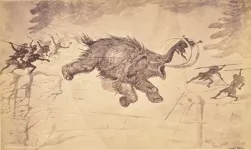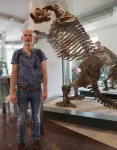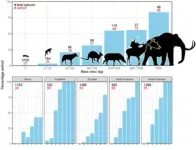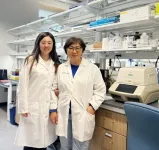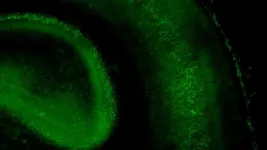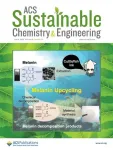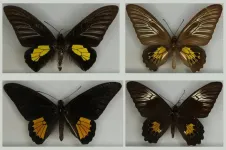(Press-News.org) The debate has raged for decades: Was it humans or climate change that led to the extinction of many species of large mammals, birds, and reptiles that have disappeared from Earth over the past 50,000 years?
By "large," we mean animals that weighed at least 45 kilograms – known as megafauna. At least 161 species of mammals were driven to extinction during this period. This number is based on the remains found so far.
The largest of them were hit the hardest – land-dwelling herbivores weighing over a ton, the megaherbivores. Fifty thousand years ago, there were 57 species of megaherbivores. Today, only 11 remain. These remaining 11 species have also seen drastic declines in their populations, but not to the point of complete extinction.
A research group from the Danish National Research Foundation's Center for Ecological Dynamics in a Novel Biosphere (ECONOVO) at Aarhus University now concludes that many of these vanished species were hunted to extinction by humans.
Many different fields of research
They present this conclusion in a review article invited by and published in the scientific journal Cambridge Prisms: Extinction. A review article synthesizes and analyses existing research within a particular field.
In this case, the researchers from Aarhus University incorporated several research fields, including studies directly related to the extinction of large animals, such as:
- The timing of species extinctions
- The animals' dietary preferences
- Climate and habitat requirements
- Genetic estimates of past population sizes
- Evidence of human hunting
Additionally, they included a wide range of studies from other fields necessary to understand the phenomenon, such as:
- Climate history over the past 1-3 million years
- Vegetation history over the past 1-3 million years
- Evolution and dynamics of fauna over the past 66 million years
- Archaeological data on human expansion and lifestyle, including dietary preferences
Climate change played a lesser role
The dramatic climate changes during the last interglacial and glacial periods (known as the late Pleistocene, from 130,000 to 11,000 years ago) certainly affected populations and distributions of both large and small animals and plants worldwide. However, significant extinctions were observed only among the large animals, particularly the largest ones.
An important observation is that the previous, equally dramatic ice ages and interglacials over the past couple of million years did not cause a selective loss of megafauna. Especially at the beginning of the glacial periods, the new cold and dry conditions caused large-scale extinctions in some regions, such as trees in Europe. However, there were no selective extinctions of large animals.
"The large and very selective loss of megafauna over the last 50,000 years is unique over the past 66 million years. Previous periods of climate change did not lead to large, selective extinctions, which argues against a major role for climate in the megafauna extinctions," says Professor Jens-Christian Svenning. He leads ECONOVO and is the lead author of the article. He adds, "Another significant pattern that argues against a role for climate is that the recent megafauna extinctions hit just as hard in climatically stable areas as in unstable areas."
Effective hunters and vulnerable giants
Archaeologists have found traps designed for very large animals, and isotope analyses of ancient human bones and protein residues from spear points show that they hunted and ate the largest mammals.
Jens-Christian Svenning adds, "Early modern humans were effective hunters of even the largest animal species and clearly had the ability to reduce the populations of large animals. These large animals were and are particularly vulnerable to overexploitation because they have long gestation periods, produce very few offspring at a time, and take many years to reach sexual maturity."
The analysis shows that human hunting of large animals such as mammoths, mastodons, and giant sloths was widespread and consistent across the world.
It also shows that the species went extinct at very different times and at different rates around the world. In some local areas, it happened quite quickly, while in other places it took over 10,000 years. But everywhere, it occurred after modern humans arrived, or in Africa's case, after cultural advancements among humans.
…in all types of environments
Species went extinct on all continents except Antarctica and in all types of ecosystems, from tropical forests and savannas to Mediterranean and temperate forests and steppes to arctic ecosystems.
"Many of the extinct species could thrive in various types of environments. Therefore, their extinction cannot be explained by climate changes causing the disappearance of a specific ecosystem type, such as the mammoth steppe – which also housed only a few megafauna species," explains Jens-Christian Svenning. "Most of the species existed under temperate to tropical conditions and should actually have benefited from the warming at the end of the last ice age."
Consequences and recommendations
The researchers point out that the loss of megafauna has had profound ecological consequences. Large animals play a central role in ecosystems by influencing vegetation structure (e.g., the balance between dense forests and open areas), seed dispersal, and nutrient cycling. Their disappearance has resulted in significant changes in ecosystem structures and functions.
"Our results highlight the need for active conservation and restoration efforts. By reintroducing large mammals, we can help restore ecological balances and support biodiversity, which evolved in ecosystems rich in megafauna," says Jens-Christian Svenning.
FACTS: The numbers of extinct and surviving species come from the freely accessible database PHYLACINE 1.2.1, which lists all known mammals that have lived in the past 129,000 years, including those that have gone extinct recently or are only found in captivity. END
The evidence is mounting: humans were responsible for the extinction of large mammals
Human hunting, not climate change, played a decisive role in the extinction of large mammals over the last 50,000 years. This conclusion comes from researchers at Aarhus University, who reviewed over 300 scientific articles
2024-07-01
ELSE PRESS RELEASES FROM THIS DATE:
Common respiratory infections may have protected children from COVID-19, study suggests
2024-07-01
Analyzing nasal swabs taken during the pandemic, researchers at Yale School of Medicine suggest that the frequent presence of other viruses and bacteria may have helped to protect children from the worst effects of COVID-19 by boosting their immune systems. Their results will be published July 1 in the Journal of Experimental Medicine (JEM).
Children are generally more susceptible than adults to respiratory infections such as the common cold, and yet, for unknown reasons, the SARS-CoV-2 virus tends to cause less severe ...
Ochsner Medical Center – Baton Rouge performs robotic-assisted lung biopsy
2024-07-01
BATON ROUGE, La. – Ochsner Medical Center – Baton Rouge now offers robotic-assisted bronchoscopy using the Ion robotic platform, a new, minimally invasive option for lung biopsy.
With bronchoscopy, doctors insert a long, thin tube with a camera to examine lung tissue and retrieve a biopsy sample. The Ion robot enables doctors to perform a biopsy quicker and safer than ever before.
These advancements are especially critical for treating lung cancer, since early detection is key to achieving the best outcome. Every six weeks of delayed treatment lowers ...
Daily sauna time might help prevent menopause-related weight gain
2024-07-01
Chicago (July 1, 2024) — New research performed with mice suggests that daily time in a warm environment such as a sauna might help older adults, especially women, combat age-related obesity and insulin resistance. The study shows the potential of heat treatments as a simple way to promote healthier aging.
The researchers found that older female mice receiving a daily 30-minute whole-body heat treatment gained less weight and showed improved use of insulin, which helps control blood sugar. The investigators ...
Researchers thwart resistant bacteria’s strategy
2024-07-01
Antibiotic resistant bacteria are experts in evolving new strategies to avoid being killed by antibiotics.
One such bacterium is Pseudomonas aeruginosa, which is naturally found in soil and water, but also hospitals, nursing homes and similar institutions for persons with weakened immune systems are home for strains of this bacterium. As many P. Aeruginosa strains found in hospitals are resistant to most antibiotics in use, science is forced to constantly search for new ways to kill them.
Now, at team of researchers from Department of Biochemistry and Molecular Biology and Department of ...
Finding the sweet spot in brain development
2024-07-01
Not everything in the brain is meant to last. As our brains assemble, trillions of neural connections have to be built or torn down at the right time and place. Otherwise, the seeds of disorders like autism can take root. Cold Spring Harbor Laboratory Assistant Professor Gabrielle Pouchelon studies how the brain is wired early in life. In doing so, she hopes to find the origins of various brain dysfunctions and new ways to treat them.
In a new study, Pouchelon and her team zero in on a process known as pruning. This is when the brain removes unnecessary connections between ...
New national volunteer leaders to guide American Heart Association into second century
2024-07-01
DALLAS, July 1, 2024 — The American Heart Association, celebrating 100 years of lifesaving service as the world’s leading nonprofit organization focused on heart and brain health for all, has named its volunteer leadership for fiscal year 2024-25. Keith Churchwell, M.D., FAHA, serving as the new volunteer president, and Marsha Jones, continuing a two-year term as volunteer board chairperson, will help guide the Association as it enters its second century. Churchwell and Jones are long-time volunteer leaders for ...
Geological Society of America reduces student membership dues to $25
2024-07-01
FOR IMMEDIATE RELEASE
1 July 2024
The Geological Society of America
Release No. 24-06
Contact: Jason Elkins
+1-303-357-1026
jelkins@geosociety.org
Boulder, Colo., USA: The Geological Society of America (GSA) is excited to announce a significant reduction in membership fees for students. Effective 1 July 2024, undergraduate and graduate students majoring in geology or related sciences can sign up for an annual student membership for just $25. This initiative underscores GSA's commitment to supporting the next generation of geoscientists by making membership more accessible and affordable.
The ...
Melanin from cuttlefish ink as a sustainable biomass resource
2024-07-01
Every year, the negative effects of human activities on the environment become increasingly clear. From climate change and microplastics to the endangerment and extinction of countless species, it is evident that we need to find new ways to achieve sustainability. Fortunately, many research groups in prominent fields like chemistry and materials science are tirelessly working to develop solutions to get us closer to circular and sustainable economies.
One area that has attracted much attention in this regard is biomass upcycling. It refers to the transformation of naturally available organic materials into ...
AI-powered study explores under-studied female evolution
2024-07-01
Pioneering AI-powered research on butterflies has probed the under-studied evolution of females and adds to a debate between the founding fathers of evolution.
The University of Essex study – published in Communications Biology – explores a controversy between Victorian scientists Charles Darwin and Alfred Russel Wallace.
Darwin thought males had more variation, as females often chose mates based on male appearance.
Whereas Wallace thought natural selection across sexes was the biggest factor in difference.
For over a century, scientists ...
New findings may fix the replicability crisis in microbiome research
2024-07-01
Our bodies are inhabited by trillions of microorganisms, with specific microbes unique to each individual. Through experimentation, scientists have pinpointed certain factors that account for variation in the gut: diet, living conditions, exercise and maternal line. Now, scientists at University of California San Diego have discovered another factor that affects the composition of the gut microbiome: time of day. In fact, the scientists have found that time of day is such an important factor that they’re calling on the National Institutes of Health (NIH) to require researchers ...
LAST 30 PRESS RELEASES:
Strategic river sensors could have forewarned of Texas Camp flood disaster
Drone sampling of whale breath reveals first evidence of potentially deadly virus in Arctic
Roman soldiers defending Hadrian’s Wall infected by parasites, study finds
Pinochet’s prisoners were tormented with music but still found solace in it, a new book reveals
Fertility remains high in rural Tanzania despite access to family planning
AI-assisted device can improve autism care access
Kinetic careers
Uncovering how parasitic plants avoid attacking themselves to improve crop resistance
Nanoparticle vaccine strategy could protect against Ebola and other deadly filoviruses
Study finds brain care score can predict risk of stroke across racial groups
Key lung immune cells can intensify allergic reactions
Do hormones explain why women experience more gut pain?
New materials conduct ions in solids as easily as in liquids
Breakthrough of the Year: Renewable energy begins to eclipse fossil fuel-based sources
LLM use is reshaping scientific enterprise by increasing output, reducing quality and more
Introducing LightGen, a chip for ultra-fast, ultra-efficient generative AI
Astronomers see fireworks from violent collisions around nearby star
ACC/AHA issue new guideline on managing congenital heart disease in adults
Cosmic crash caught on camera
Is talented youth nurtured the wrong way? New study shows: top performers develop differently than assumed
Ants: An untapped resource in the development of antibiotics?
Archaeologists use AI to create prehistoric video game
Mitochondria migrate toward the cell membrane in response to high glucose levels
Tiny viral switch offers hope against drug-resistant bacteria
Most parents aware of early peanut introduction guidelines, but confused about details
HPV vaccine can protect against severe lesions of the vulva and vagina
Virtual care provision and emergency department use among children and youth
Quadrivalent HPV vaccine and high-grade vulvovaginal lesions
Insights into dry eyes gained from stem cell-derived tear glands
Researchers identify 166 human pluripotent stem cell lines available for use in clinical applications
[Press-News.org] The evidence is mounting: humans were responsible for the extinction of large mammalsHuman hunting, not climate change, played a decisive role in the extinction of large mammals over the last 50,000 years. This conclusion comes from researchers at Aarhus University, who reviewed over 300 scientific articles
